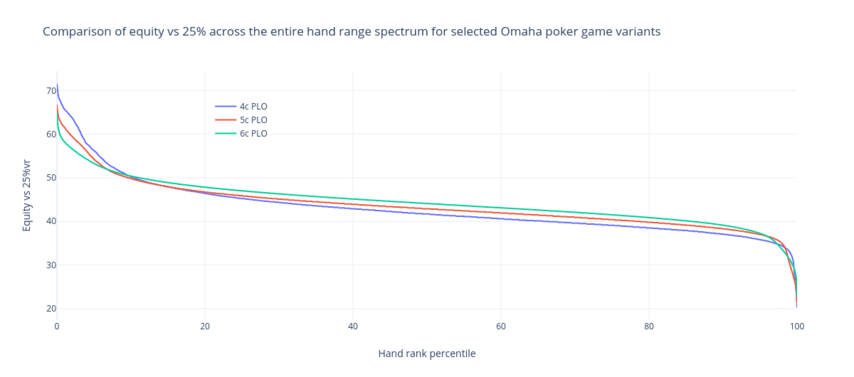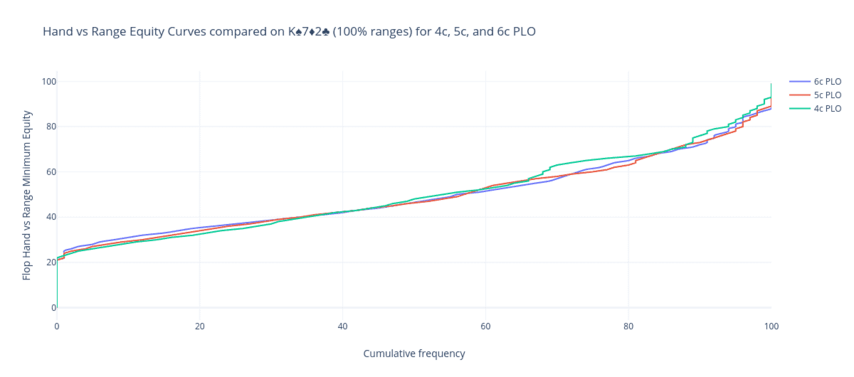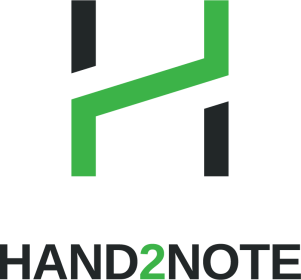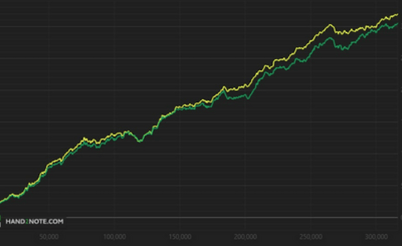What is the strongest starting hand in Six Card Omaha?
If you are already familiar with the basics of this discipline, your immediate answer should be “Depends on the situation.” Therefore, I will ask a more specific question: “We 3-bet on the button after a raise from a regular, he makes a 4-bet. What is the strongest hand we can have in this situation?
As a hint, look at the table of four starting hands. One of them will be the correct answer. The second column shows equity against the top 10% of hands. Which hand will be the strongest and why?
| Starting hand | Equity vs top 10% |
|---|---|
| 64% | |
| 62% | |
| 61% | |
| 58% |
Correct answer – , because it is the only hand that blocks your opponent's aces. In fact, it has 60% against the top 5% of the range, which is already significantly shortened due to blocked cards.
The strongest hand for putting aces into aces is , which has 59% equity preflop if your opponent 4-bet all of his aces, and only has 56% against a 4-betting range of only strong aces.
Anyone who automatically 4-bets with aces should pay attention to the following example: there will be 46% equity against the top 2% of the range, and against weak aces like and it will reach 57%. Obviously, preflop equity in six-card Omaha cannot be remembered using the same simplified models that many are familiar with from classical Omaha.
Equity of starting hands in six-card Omaha
It will come as no surprise to anyone that the equity of starting hands in 6-card Omaha is noticeably closer than in 4- or 5-card variations of the game. Although the average coach will draw some banal conclusion from this, like “the variance in six-card Omaha will be much higher,” I suggest looking a little deeper. The chart below shows the preflop equity distribution for each starting hand against a linear range of the top 25% of hands for the 4, 5, and 6-card Omaha variations.

Although most of the curve in the six-card variety is flatter than in the 4- and 5-card variety, the largest divergence between the three games occurs in the top 10% of starting hands. Simply put, at six cards you will rarely have a hand with 60% equity against an opponent with a 25% range.
There are several conclusions that can be drawn from this equity distribution, one of which I will focus on in this article (if you need the rest – sign up for the Cardquant course !): the optimal 3-bet range without position will be much narrower in 6 cards than in classic Omaha.
If preflop the equity of the starting hands is close to each other, and on the river, the same hierarchy of hands applies as in other variations of Omaha (a particular hand wins, loses, or splits the pot), then how will the distribution of equity on the flop change?
Let's look at the flop .
Below in the chart I have shown the equity distribution (100% of the range vs. 100% of the range) for four, five, and six-card Omaha. The curves are not identical, but the general distribution of hand strengths on the flop is very similar for all disciplines. Unlike preflop, equity does not cluster between 40% and 60% in either 6-card Omaha or the classic and five-card varieties.

Although this is just one hand and not a complete proof, I would argue that in 6-card Omaha, flop equity is not as closely related to preflop equity as it is in 5 or 4-card Omaha. It follows that the standard strategy, in which we increase the size of the pot preflop with a strong range, will not show sufficient profit.
Instead, the optimal preflop strategy evaluates each hand under specific hand conditions. The heuristics for assessing hand strength in 6-card are not as simple and depend on context much more than in other varieties of Omaha. The second half of the article will serve as a basic guide to how to analyze the value of some of the properties of pocket cards.
Flush value in six-card Omaha
The table shows the frequency with which you will get a two-suited hand in each variation of Omaha. In six-card, you will rarely receive hands with the same suit – unlike four cards. Moreover, in six-card, you will get a three-suited hand 9.3% of the time.
| Variation of Omaha | Proportion of double-suited hands |
|---|---|
| PLO 4 cards | 13.5% |
| PLO 5 cards | 46.8% |
| PLO 6 cards | 79.5% |
How often will these hands flop flush draws? I've put together a table below that shows how often your draw will be dominated heads-up against 100% of your range.
| Flush draw | PLO 4 cards | PLO 5 cards | PLO 6 cards |
|---|---|---|---|
| 6-high | 17% | 27% | 37% |
| T-high | 13% | 20% | 28% |
| J-high | eleven% | 16% | 23% |
| Q-high | 8% | 12% | 17% |
| K-high | 4% | 7% | 9% |
Of course, studying the value of flushes in six-card Omaha will require a more in-depth analysis, but from this table, it is already clear that a Q-high flush in six-card Omaha has almost the same value as a 6-high in four-card Omaha. One exception you can think of is that if your opponent heavily shifts the frequency of his actions with nut or second nut flushes, then you will be able to play Q-high flushes for value as an exploit.
However, it is important to realize how weak Q-high flushes are pre-flop, even heads-up. If we extend this logic to 6-max, then the obvious first-order heuristic is to only play A-high and K-high flushes in multipots. Please note that 9.8% of starting hands are combinations like {AxxKxx, AxxAxx, KxxKxx}. This can be a useful starting point for constructing preflop ranges.
Now that we've covered the weaknesses of Q-high and lower flush draws, it's logical to assume that other hand properties become more important. And this is true: consider the relative strength of the straight draw.
The value of a straight draw in six-card Omaha
In 83% of cases, a board comes to the river on which at least one straight or flush is possible. In 28% of cases the straight will be the nuts (i.e. there will be no pairs or three cards of the same suit). The difference between 6-card Omaha and other variations of Omaha is that when the strongest hand on the board is a straight, it is much more important to have the nut straight.
| Number of possible straights to the river | Example | PLO 4 cards | PLO 5 cards | PLO 6 cards |
|---|---|---|---|---|
| One | 9% | 15% | 21% | |
| Two | 17% | 25% | 35% | |
| Three | 24% | 35% | 45% |
The probability that a random hand will have a straight
It's not just that 6-card will make random hands turn into straights more often, but it also increases the relative strength of the straight draw. In some hands, a wrap + flush draw, a wrap + two pair, and even just a wrap will stand up well even against a set with a redraw! Let's illustrate this with three examples.
| Your hand | Board | Opponent's hand | Equity |
|---|---|---|---|
| 53% – 47% | |||
| 64% – 36% | |||
| 47% – 53% |
Three key takeaways that you can immediately apply at the tables:
- In six-card Omaha, flop equity is not as closely tied to preflop equity compared to other PLO variations.
- A six-card Q-high flush has the same value as a low flush in classic Omaha.
- When a straight is the strongest possible hand, the fact that you have the nut straight often matters.
Where to play?
Testing the theory in practice in classic rooms is not so easy: six cards are played on PokerStars.
The “big game” is on mobile apps: both PPPoker and PokerBros have dozens of tables available up to the highest limits. Alliances and clubs are aimed at players from different regions, so the game can be found almost around the clock.
Which clubs should you pay attention to at PokerBros:
– Alliance Panamericana , Club SERENGETI. RB 35%, 1 Chip=0.95 USD – Paradise
Alliance, Geography club. RB 35%,1 Chip=0.95 USD – RGS United Alliance, 4TH STREET Club. RB 35%,1 Chip=0.9 USD – PkrBros Ireland Alliance. RB 35%,1 Chip=0.95 GBR
There is also access to the largest and most famous Diamond alliance.
For those who like uncharted territory, there is the Brazilian app SupremaPoker. The game is played at limits from $0.02/$0.04 to $2/$4.
H2N does not currently support six-card Omaha; the developers promise to add functionality with the release of Hand2Note version 4. But HM3 supports PLO 6 cards through the Kinghands converter.
As usual, access to all clubs is provided by GT+. If you have never played in applications, just write to any of the contacts: we will explain and tell you everything, we will help you install the software and solve any technical problem through TeamViewer.
Advantages of playing with GT+:
– Full technical support: we will help you set up the software, share proxies, and solve any technical problem.
– A wide selection of methods for deposit and cashout, from crypto to transfers to Sberbank, Alfa, and Tinkoff.
Referral program for referring friends, bonuses for active play (up to +5% rakeback in any clubs), payment for subscriptions to H2N and converters, discount in the GipsyTeam store.
👨💻 The most professional support. We respond instantly, communicate in a friendly manner, never delay payments, and are cooperative in controversial situations.














